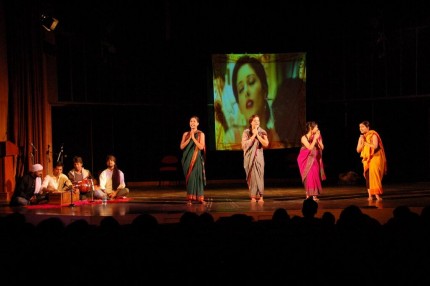Manisha Priyam describes how Delhi is commemorating the first anniversary of the brutal gang rape of a student in the nation’s capital. This article first appeared in Live Mint.
Even as euphoria over the fledgling Aam Aadmi Party’s (AAP’s) stellar performance in the Delhi state elections reached a crescendo at Jantar Mantar this week, the national capital was moving quietly towards remembering an incident in the city that triggered nationwide outrage last year.
 Scene from “Museum of Species in Danger”. Photo credit: @ReallySwara
Scene from “Museum of Species in Danger”. Photo credit: @ReallySwara
16 December marks the first anniversary of the brutal gang-rape of a 23-year-old physiotherapy student on a moving bus in the national capital. She was attacked when she was returning home with a friend after watching the movie Life of Pi, the enthralling story of survival of a young boy, who after a shipwreck spends 227 days on-board a lifeboat in the Pacific Ocean in the company of a tiger named Richard Parker.
The Delhi victim didn’t survive; 13 days after being raped and brutalised, she died in a hospital in Singapore, where she was taken for treatment of the injuries she suffered in the attack. Her story is that of the city’s aam aurat (ordinary woman), educated and aspiring to work. The ordinary woman who watches a movie for leisure and takes a bus back home, in the full glare of city lights, her friend by her side. That her exercise of her right to liberty should be the cause of a violent end to her right to life is testimony to the beastly dualism of gender inequality that undergirds the city.
On 10 December, students from campuses around the city launched Jurrat, a week-long campaign with the slogan Aazaad Chalo, Bebaak Chalo (walk with freedom from fear). Songs of protest by theatre groups Swaang and Majma, and a play, “Museum of Species in Danger”, highlight the derogatory commercial portrayal of the feminine body in Bollywood hit numbers. Heightening a fictitious image of the female body as a hedonistic site, these songs have borrowed from a variety of Indian languages and commercialised the female body.
The play conveys a sense of historical timelessness—mythological Sita to real-life Mathura and Bhanwari Devi, and the woman who was raped and killed last December, and the many names of ordinary women, violated on a daily basis in their homes, in schools and colleges, and on social networking websites among others.
It is not simply the migrant underclass that is the violator of the right to equality of the aam aurat, nor is the outrage that followed the Delhi gang-rape a volcanic eruption of the extraordinary. It is how we lead our ordinary lives as a festering sore of women’s indignity that is responsible for these abominable tragedies. Campaigns against corruption and for electoral participation, important though they may be, have as yet no answers to these routine practices, which do not seem like a breaking news item. This power lies with persistent protest, which dares to interrogate the macro-political, as also the minute glare, and the touch or pinch meant to violate.
The electoral performance of the AAP has as its underpinnings the silent grieving of the ordinary women who wield the jhaadu (broom). As they pressed the electronic voting machine buttons in Delhi on 4 December, it was only one possible way of registering their protest.
On 16 December, as protest marches led by women from Madanpur Khadar, Munirka village, Seemapuri, Trilokpuri, Mangolpuri and Bhalswa resettlement colony retrace the Delhi victim’s last journey, the city will hang its head in shame. It’s a tale of two cities—its victory is humbled by its violation of the rights of equality of the weak and the underclass, of its women and its children. Let the victory rallies give way to this silent march and songs—Rabbi Shergill, Swanand Kirkire, Swara Bhaskar, Sona Mohapatra will join in. This is indeed the way to right the wrongs of the city.
About the Author
Manisha Priyam is ICSSR Fellow at the Nehru Memorial Museum and Library. She received her doctorate from LSE’s Department for International Development in 2012.
Manisha is a regular contributor to the India at LSE blog. See here for more posts.







